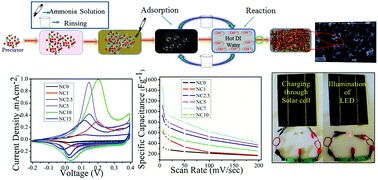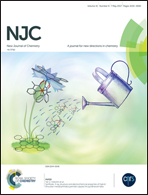Tuning the electro-chemical properties by selectively substituting transition metals on carbon in Ni/Co oxide–carbon composite electrodes for supercapacitor devices†
Abstract
Carbon black (CB) decorated Ni/Co oxide composite electrodes are fabricated in situ with variable CB percentages by using the successive ionic layer adsorption and reaction (SILAR) method. This green process tuned the metal ion concentration on carbon and offered binder-free, facile and scalable features. The structure, morphology and electrochemical performances of the developed nanocomposites are characterized using various sophisticated techniques. An elemental study suggested the substitution of more Ni2+ in NixCo1−xO4 with varying carbon concentrations, which was correlated with the change in the relaxation rate of the composites. X-ray photoelectron spectroscopy confirmed the presence of Ni2+ and Ni3+ in the Ni/Co–carbon composites, which are additionally responsible for improving the conductivity of the developed electrodes. Also, conductive atomic force microscopy supported the improvement in the local conductivity of NC7 compared to NC0. NC7 electrodes demonstrated a specific capacitance of around 1811 F g−1 at a current density of 0.5 mA cm−2 with excellent cyclic retention (92% even after 8000 cycles) and energy density (91 W h Kg−1). Further, NC7 electrodes are used to fabricate an asymmetric solid state supercapacitor device (capacitance around 258 F g−1), and are connected to a commercial solar cell for storing energy, which is effective to light a commercial LED.



 Please wait while we load your content...
Please wait while we load your content...